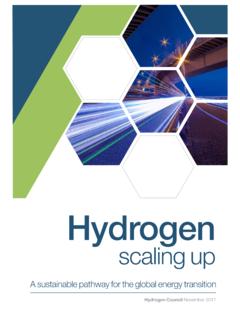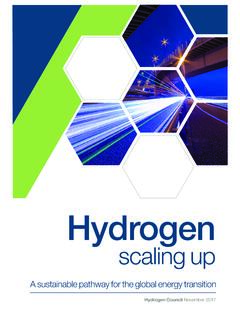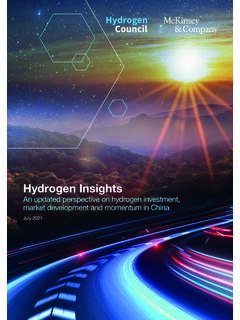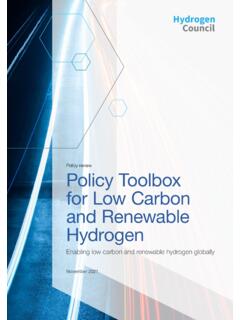Transcription of Hydrogen for Net-Zero
1 Hydrogen for Net-Zero A critical cost-competitive energy vector November 2021. Published in November 2021 by the Hydrogen Council. Copies of this document are available upon request or can be downloaded from our website: This report was authored by the Hydrogen Council in collaboration with McKinsey & Company. The authors of the report confirm that 1. There are no recommendations and / or any measures and / or trajectories within the report that could be interpreted as standards or as any other form of (suggested) coordination between the participants of the study referred to within the report that would infringe the EU competition law;. and 2. It is not their intention that any such form of coordination will be adopted.
2 Whilst the contents of the Report and its abstract implications for the industry generally can be discussed once they have been prepared, individual strategies remain proprietary, confidential and the responsibility of each participant. Participants are reminded that, as part of the invariable practice of the Hydrogen Council and the EU competition law obligations to which membership activities are subject, such strategic and confidential information must not be shared or coordinated including as part of this Report. 2. Hydrogen for Net-Zero Hydrogen Council, McKinsey & Company TABLE OF CONTENTS. Executive summary iii Introduction 8. Chapter 1. Demand for Hydrogen and its cost- and carbon- cutting role 12. Chapter 2.
3 Scaling through 2030 is critical for meeting long-term targets 22. Chapter 3. Hydrogen momentum and required investments 34. Chapter 4. Action is required 44. Appendix Methodology 48. Glossary 53. Bibliography 54. Hydrogen for Net-Zero 3. Hydrogen Council, McKinsey & Company Executive summary iv Hydrogen for Net-Zero Hydrogen Council, McKinsey & Company Hydrogen is central to reaching net zero emissions because it can abate 80 gigatons of CO2 by 2050. Hydrogen has a central role in helping the world reach Net-Zero emissions by 2050 and limit global warming to degrees Celsius. Complementing other decarbonization technologies like renewable power, biofuels, or energy efficiency improvements, clean Hydrogen (both renewable and low carbon) offers the only long-term, scalable, and cost-effective option for deep decarbonization in sectors such as steel, maritime, aviation, and ammonia.
4 From now through 2050, Hydrogen can avoid 80 gigatons (GT) of cumulative CO2 emissions. With annual abatement potential of 7 GT in 2050, Hydrogen can contribute 20% of the total abatement needed in This requires the use of 660 million metric tons (MT) of renewable and low- carbon Hydrogen in 2050, equivalent to 22%b of global final energy demand. Hydrogen is critical in enabling a decarbonized energy system. It facilitates the integration of renewably produced energy because Hydrogen can store energy, provide resilience, and transport high volumes of energy over long distances via pipelines and ships. Hydrogen allows energy companies to tap extremely competitive, but otherwise stranded renewable energy in remote locations.
5 This accelerates the energy transition as it allows more renewables to be built. Finally, because Hydrogen can be produced from electricity and used as, or converted into, fuels, chemicals, and power, the production of Hydrogen from electricity will connect and fundamentally reshape current power, gas, chemicals, and fuel markets. In terms of end uses, Hydrogen is critical for decarbonizing industry ( , as feedstock for steel and fertilizers), long-range ground mobility ( , as fuel in heavy-duty trucks, coaches, long- range passenger vehicles, and trains), international travel ( , to produce synthetic fuels for maritime vessels and aviation), heating applications ( , as high-grade industrial heat), and power generation ( , as dispatchable power generation and backup power).
6 China, followed by Europe and North America, will be the largest Hydrogen markets in 2050, together accounting for about 60% of global demand. Fulfilling this decarbonization role will require a large scale-up of clean Hydrogen production in the coming decades. Supplying 660. MT to end-uses will require 3 to 4 terawatts (TW) of electrolysis capacity and about to TW of renewable generation capacity, as well as 140 to 280 MT of reforming capacity for low- carbon Hydrogen production and associated infrastructure to store about 1 to GT of CO2 a year. In such a supply scenario, renewable energy for Hydrogen will account for roughly 15% to 25% of the 27 TW of total new renewable energy required by 2050c to reach net zero a 10x increase over the TW installed today.
7 Scaling through 2030 is critical for meeting long-term targets and unlocking cost-efficient decarbonization opportunities Setting our energy system on a trajectory to Net-Zero requires firm commitment and rapid acceleration. We estimate the deployment of 75 MT clean Hydrogen is needed by 2030 an ambitious, yet achievable target. This supply of clean Hydrogen can replace 25 MT of grey Hydrogen in ammonia, methanol, and refining; 50 billion liters of diesel in ground mobility; and 60 MT of coal used for steel production. Early growth in clean Hydrogen deployment will likely center on Europe, Japan, and Korea, which will account for about 30% of new clean demand. China and North America significantly larger Hydrogen markets today will follow closely with about 20% of demand for clean Hydrogen each.
8 Hydrogen for Net-Zero v Hydrogen Council, McKinsey & Company To supply this demand in a cost-optimal way, a mix of both renewable and low-carbon Hydrogen supply would require 200 to 250 gigawatts (GW) of electrolyzer capacity and 300 to 400 GW. of new renewables, as well as 45 to 55 MT of low-carbon Hydrogen production capacity and associated carbon infrastructure to store 350 to 450 MT of CO2 a year. This will create the need to step up the deployment of renewables: in 2020, 260 GW of capacity was commissioned. A. further acceleration is required to meet rising electrification demand. This deployment of clean Hydrogen will not happen without the right regulatory framework . both governments and businesses need to act.
9 Requirements include a set of suitable policies such as mandates and robust carbon pricing, the development of large-scale infrastructure, and targeted support and de-risking of large initial investments. These investments will pay off; scaling Hydrogen is the key to reducing costs through economies of scale, making Hydrogen available to end-users through the necessary infrastructure, and ultimately making Hydrogen a competitive, available, cost-efficient decarbonization vector. In this report, the use of clean Hydrogen would abate as much as 730 MT of CO2 annually in 2030, the equivalent to more than the annual CO2 emissions in 2019 of the UK, France, and Belgium combined. The decarbonization contribution from clean Hydrogen use will differ per end-use segment: Current industrial uses: A large share of the decarbonization will come from current industrial uses of Hydrogen with 270 MT of CO2 avoided a year, particularly from the decarbonization of refining and ammonia synthesis.
10 These applications are among the most attractive uses for early deliverable low-carbon Hydrogen , at carbon abatement costs for high-purity emission streams of USD 50 to 100 a ton in most regions. Ground mobility: In the ground mobility sector Hydrogen could avoid about 90 MT of CO2. emissions in 2030. By about 2030, Hydrogen -powered vehicles ( , heavy-duty trucks, coaches, long-range passenger vehicles, and rail) could achieve cost parity with internal combustion engine (ICE) vehicles, leading to a significant scale-up. Given heavy payloads and long distances traveled, trucks account for the biggest share of the abatement. With a share of about 11% of global heavy-duty truck sales in 2030, emissions of about 60 MT of annual CO2.













